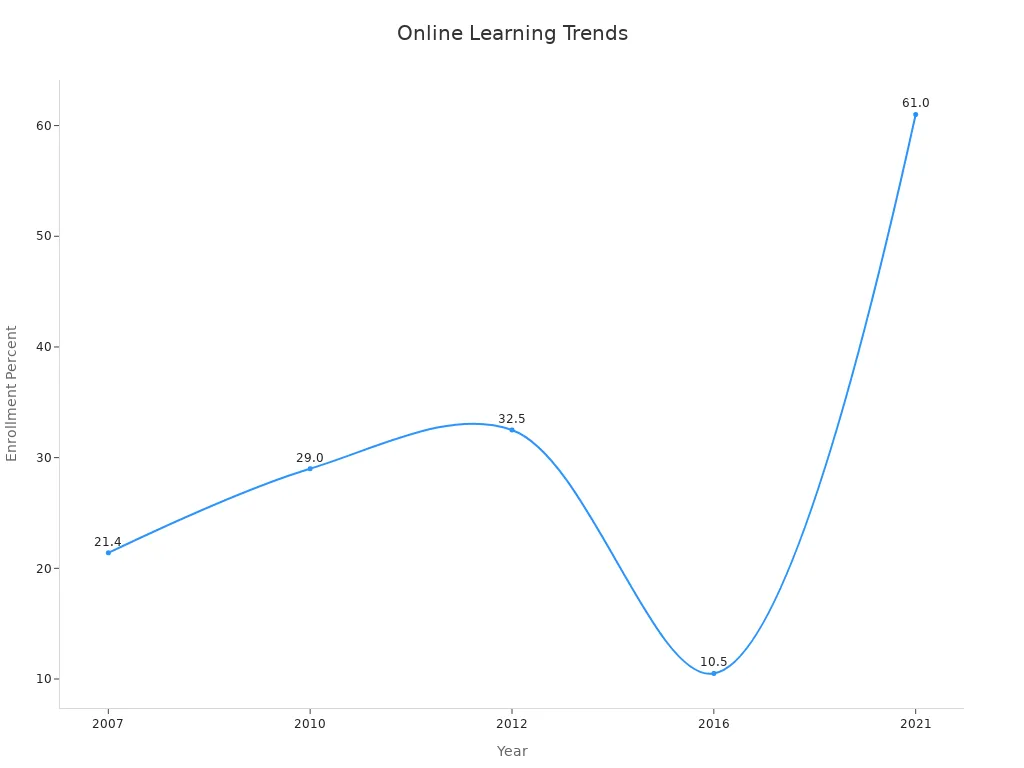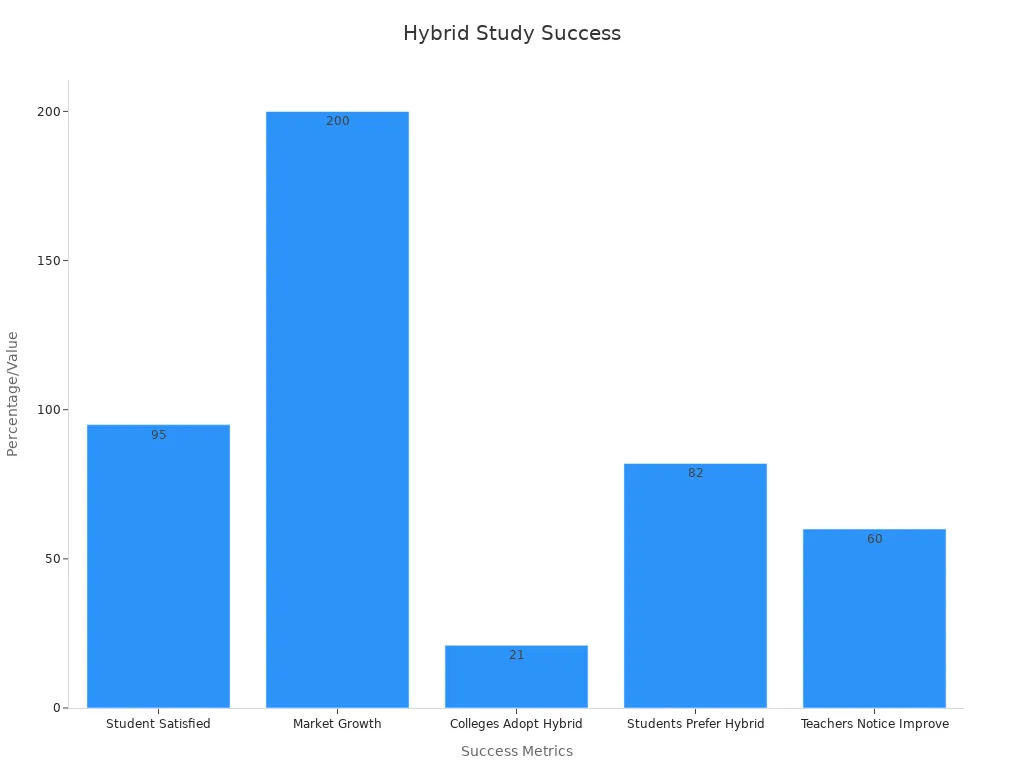Traditional Study Methods Compared to Modern Approaches

Education is key to progress, shaping students' minds for the future. However, how we learn has changed significantly over time. Traditional study methods relied on strict routines and in-person teaching, while modern approaches utilise technology and data to enhance learning. For instance, schools employing data-driven teaching have seen improvements in results by 30%. This demonstrates the power of contemporary methods. Nevertheless, 67% of school plans still adhere to traditional ways or the preferences of leaders. This indicates a need for a blend of both methods.
So, how can we compare these approaches to help all students learn better?
Key Takeaways
Old-fashioned study ways give structure and face-to-face learning. They help students stay disciplined and improve social skills.
Newer teaching styles keep students interested and allow flexibility. Technology is used to make learning better and more fun.
Using both old and new methods creates a good balance. It helps students stay focused and think more deeply.
Online learning is flexible and easy to access from anywhere. But it needs self-control and a strong internet connection to work well.
Setting clear goals and using different tools can help learning. It makes studying more fun and fits each person’s needs.
Understanding Traditional Study Methods
Definition and Characteristics
Traditional study methods are old ways of learning. They use set routines, face-to-face teaching, and books. These methods include teachers leading lessons, writing notes, and studying from textbooks. You might know these as the usual classroom style, where teachers follow a planned schedule.
Main features of traditional methods include talking in person, memorising facts, and using printed books. These methods focus on discipline and regular habits. For example, traditional classrooms stick to strict timetables, so students study at fixed times.
Strengths of Traditional Study Methods
Traditional methods have lasted long because they work well. They give a steady way to learn, helping you stay organised. Here are some key benefits:
Personal Interaction: Talking directly with teachers lets you ask questions and get quick answers. This helps you understand topics better.
Discipline and Routine: Regular schedules encourage good study habits, which are important for success.
Proven Effectiveness: Studies show traditional methods work. For example, clear steps in research ensure accurate results.
Traditional classrooms also help you build social skills. You talk with classmates and teachers, which boosts confidence and teamwork. These skills are useful in life, not just in school.
Limitations of Traditional Study Methods
Even though they are helpful, traditional methods have problems. These issues can make learning harder in some cases:
Traditional studies often miss scientific detail, so results may not apply everywhere.
Too much information can confuse you, leaving less time to think deeply.
Single examples may not match real-life situations, making them less useful.
Also, traditional methods may not suit everyone’s learning style. For instance, if you like pictures or hands-on activities, studying only from books might feel boring. Depending on physical materials can also make these methods slower in today’s fast-moving world.
Exploring Modern Teaching Methods
Definition and Features
Modern teaching methods aim to make learning fun and active. These methods focus on you, the student, instead of just the teacher. They let you take charge of your learning by using tools that fit your style.
Main features of modern teaching methods include:
Learner-centric: Lessons are designed to match what you need.
Task-based: Projects and activities help you practise what you learn.
Resource-based: Videos and online tools make lessons easier to understand.
Interactive: Group tasks and discussions make learning exciting.
Collaborative: Working with classmates helps you share ideas and learn together.
These methods link lessons to real-life situations, showing how they matter. They also consider what you like and are good at, making learning more enjoyable.
Advantages of Modern Teaching Methods
Modern methods bring many benefits to improve how you learn. They make studying easier and more flexible, so you can learn at your own speed. For example, digital tools adjust lessons to focus on what you need to improve.
Here are some key benefits:
Improved engagement: Fun activities keep you interested in learning.
Critical thinking: You learn to solve problems and think deeply.
Collaboration: Group work helps you learn teamwork skills.
Convenience: Online tools let you study anytime and anywhere.
The COVID-19 pandemic showed how important technology skills are today. Modern methods prepare you for a tech-filled world by teaching problem-solving and teamwork.
Challenges of Modern Teaching Methods
Even with their benefits, modern methods have some problems. For example, test results from digital tools might come too late to help you now. Teachers may also find it hard to use new tools without proper training.
Some common challenges include:
Challenge | Description |
|---|---|
Timeliness | |
Accessibility | Teachers may struggle to use or understand the data. |
Training | Many teachers don’t know how to use modern tools well. |
Investment | New tools can cost a lot of time and money. |
Complexity | Advanced tools can be hard for students and teachers to use. |
To fix these issues, schools need to provide training and resources. This will help modern methods work better for everyone.
Comparing Traditional Study Methods and Modern Teaching Methods
Differences in Learning Approaches
Traditional study methods use fixed schedules and teacher-led lessons. You follow a routine, learning in a classroom with books. These methods focus on memorising and practising to remember facts. For example, you might copy notes or do textbook exercises.
Modern teaching methods are more flexible and personalised for you. You take part in learning by using digital tools and activities. Instead of just listening, you watch videos, join group talks, or solve problems. For instance, you could work on a project online with classmates.
The main difference is how you learn the material. Traditional ways focus on discipline and habits. Modern methods encourage creativity and thinking deeply. Both are useful, depending on how you like to learn.
Effectiveness Across Various Scenarios
How well these methods work depends on the situation. Traditional methods are great when you need structure. For example, studying for exams needs reviewing notes and practising questions. This helps you cover all topics step by step.
Modern methods are better for solving tricky problems. Interactive tools and teamwork help you find creative answers. For instance, a science app lets you test ideas without a real lab.
Using both methods together can give the best results. You can use traditional ways to learn basics and modern tools to explore more. This mix helps you learn better in any situation.
Accessibility and Inclusivity
Traditional methods need physical things like books and classrooms. This can be hard for students in far places or with disabilities. Also, these methods may not suit everyone’s learning needs. For example, if reading is hard, books alone can be frustrating.
Modern methods solve many of these problems. Digital tools let more people learn from anywhere. You can use phones or tablets to access lessons. Features like subtitles and audio help students with disabilities.
But modern methods also have issues. Not everyone has good internet or new devices. Schools need to provide tools to make learning fair for all. By mixing traditional and modern ways, teachers can help every student succeed.
The Role of Distance Learning in Modern Education

Benefits of Distance Learning
Distance learning has changed education by making it easier to access. You can now learn from home or while travelling. This removes location problems, allowing more people to study. For example, the eLearning market is expected to reach $1 trillion by 2032, showing its growing role in education.
A big benefit of distance learning is its flexibility. You can plan your studies around your daily life. This helps you manage school, work, and family at the same time. It is especially helpful for people working while studying.
Also, distance learning offers many courses that employers value. These courses teach skills needed for jobs, helping you build a career. In 2020, 75% of college students took at least one online class, showing how popular this method has become.

Limitations of Distance Learning
Even with its benefits, distance learning has some downsides. Not everyone has good internet or modern devices, which can cause problems. Some students also find it hard to stay focused because distance learning needs self-control.
A study at King Saud University found lower test scores when students switched from in-person to online classes. This shows that distance learning may not always work as well as traditional methods. Also, not meeting teachers and classmates in person can make teamwork harder.
Learning Model | Module Outcome Change | Reassessment Rate Change |
|---|---|---|
Blended Learning (BL) | Decreased (4 out of 7 modules) | Increased (not significant) |
Face-to-Face (F2F) | Unaffected (1 module) | N/A |
Face-to-Face (F2F) | Improved (2 modules) | N/A |
How Distance Learning Integrates with Traditional Methods
Mixing distance learning with traditional methods combines their best parts. Online tools give flexibility, while in-person classes offer structure and personal help. For example, using real-life examples in lessons can make hard topics easier to understand.
This mix also helps students talk to each other and check their knowledge through tests. By combining these methods, you can learn skills that are useful for jobs. Studies show that e-learning works better when used with traditional methods, making it a strong choice for today’s education.
Creating a Balanced Study Strategy
Benefits of Combining Traditional and Modern Methods
Using both traditional and modern methods makes learning better. Traditional ways give structure and discipline. Modern tools add fun and flexibility. Together, they help all types of learners succeed.
For example, writing notes and talking with teachers build basics. Apps and online tools make lessons exciting and easy to access. Studies show this mix improves focus and results. It also helps you think critically, work with others, and learn independently. These skills are important for school and life.
Comparing teaching styles shows that mixing technology with old methods works well. It makes studying faster and teamwork easier. This balance helps you study smarter and get ready for real-life challenges. By using both, you can create a study plan that fits you.
Practical Tips for Hybrid Learning
To use both methods, you need a good plan. Here are some tips to help:
Set Clear Goals: Decide what you want to learn and pick the right tools.
Mix and Match: Use books for memorising and apps for fun activities.
Stay Organised: Make a schedule for online and offline tasks. Use planners to track time.
Engage Actively: Join group talks in class and online to understand better.
Reflect and Adjust: Check what works for you and change your plan if needed.
Breaking tasks into small steps makes them easier. Adding pictures or stories can make learning fun. Taking time to think about what you learn helps you remember it better.
Examples of Successful Hybrid Approaches
Many schools use hybrid learning successfully. Here are some examples:
Case Study Title | Description |
|---|---|
Using Simulations in Hybrid Education | Online practice for healthcare students during COVID-19. |
Flexible Learning with Sustainable Meta Class | Mixing classroom and online learning spaces. |
Virtual Design Critiques in Graduate Studios | Using virtual reality for design lessons. |
Cene: A Game About Climate Change | Teaching middle school students with mixed-reality games. |
These examples show how hybrid learning works in different subjects. They prove that being flexible and creative helps students learn better.
Numbers also show hybrid learning is popular. About 82% of students like it more than old methods. Also, 60% of teachers see better skills in students using this way. The chart below shows more success rates:

By following these examples, you can improve how you study. Hybrid learning not only helps you do well in school but also teaches skills for the future.
Both old and new study methods have good and bad points. Traditional ways give order and discipline, while modern ones focus on being flexible and fun. They are different in how they teach. Traditional methods use memorising and routines. Modern methods encourage teamwork and creative thinking.
Study Method | Advantages | Disadvantages |
|---|---|---|
Case Studies | Deep look at one person or small group. | Hard to apply findings to everyone. |
Observation Research | Shows how people act naturally. | Watching can change how people behave. |
Survey Research | Collects lots of information fast. | Answers might not always be honest. |
Correlational Research | Explains how things are connected. | Doesn’t prove one thing causes another. |
True Experiments | Shows clear cause and effect. | Controlled settings may not feel real. |
Choosing the right way to study depends on what you need. You might like traditional methods for their steadiness or modern tools for their flexibility. The trick is to stay open-minded. Changing your approach for different tasks will help you do well in school and get ready for the future.
FAQ
How can I mix old and new study methods?
Combine old ways like writing notes with new tools like apps. For instance, jot down key ideas from books. Then, use online quizzes to check what you’ve learned. This mix gives both structure and flexibility.
How do modern tools make studying better?
Modern tools like flashcards or videos make learning fun. They help you focus on areas where you need improvement. You can also learn at your own speed. Use them with old methods for the best results.
Are old study methods still useful today?
Yes, old methods are great for building habits and basics. They work well for subjects needing memorisation or step-by-step learning. Mixing them with new tools creates a balanced way to study.
What if I find online learning hard?
Set clear goals and plan your time wisely. Use timers to stay on track. Join online study groups for help and encouragement. If possible, combine online lessons with face-to-face tutoring.
Can hybrid learning work for every subject?
Yes, hybrid learning fits most subjects. For example, read books for theory and use online tools for practical tasks like science. Change your method based on the subject and how you learn best.
See Also
Assessing How Digital Courses Shape Contemporary Learning Environments
Cutting-Edge Teaching Strategies: Fresh Approaches for 2024
Adapting to E-Learning: Embracing Varied Learning Approaches
Understanding Inclusive Education's Role in Today's Classrooms
Transforming Learning: The Emergence of Contemporary Tutoring

